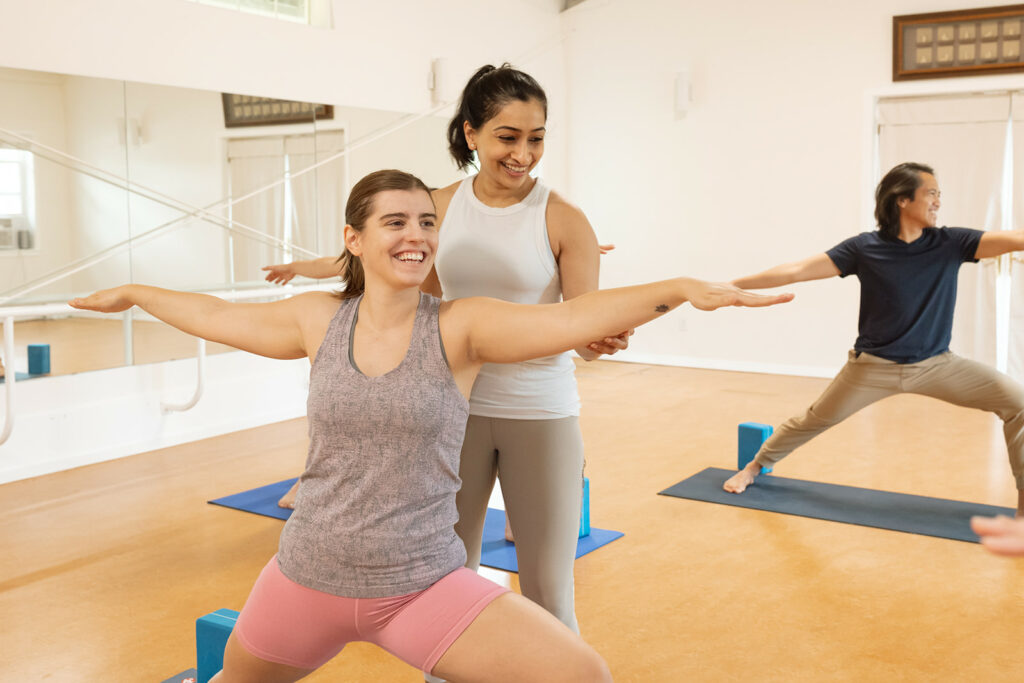3
It’s teacher training season at the studio, and I’m spending the next three months immersed in guiding aspiring yoga teachers. Each week, I watch them take those exciting yet nerve-wracking first steps toward becoming teachers themselves. It’s a constant reminder of my own journey—arriving in America as an immigrant yoga teacher at a time when Indian yoga instructors were few and far between.
Fast forward 12 years, and the landscape looks vastly different. Today, I see more diversity in the yoga teaching community, and it fills me with joy. Representation matters. This shift has created space for more authentic voices to teach yoga, bringing it closer to its origins while also making it accessible to everyone.
Looking back at my early teaching days, there are a handful of things I wish someone had told me when I first started—small lessons that would have made my journey smoother and more intentional. If I could go back and give advice to that younger version of myself, these five insights would be at the top of my list.
1. Teach Right Away – Even if You Don’t Feel Ready
The best way to grow as a yoga teacher is to start teaching immediately after completing your training. Even if you feel unprepared or uncertain, stepping into a class and teaching real students will accelerate your learning in ways no textbook or practice session ever could. You refine your skills by being in the trenches—teaching live classes, handling unexpected questions, reading the room, and adapting sequences on the spot.
After you graduate from a solid yoga teacher training (whether it’s good or great), commit to teaching as much as possible for at least six months to a year. The goal during this time is to build confidence, develop your voice, and sharpen your interpersonal skills. Don’t overthink it—whether it’s subbing at local studios, offering free classes to friends, or teaching in community spaces, just say “yes.” Once you’ve built some experience, you can become more selective about where and what you teach.
The biggest trap new teachers fall into is waiting—waiting for the perfect moment, the perfect studio, or for themselves to feel perfectly “ready.” But the truth is, that moment rarely comes. My personal mantra has always been, Do it scared. It’s in doing the hard things—even when fear is present—that you become a better, more capable teacher.
2. Stick to a Few Well-Tested Sequences
One of the hardest things for new yoga teachers is resisting the urge to constantly switch up class plans and sequences. It’s easy to fall into the trap of thinking that every class needs to be new, complex, or physically challenging to keep students engaged or to gain their approval. But new doesn’t always mean better, and chasing novelty can lead to confusion—for both you and your students.
A better approach is to create five to eight solid class plans or sequences that you know work well for a range of students. These can include foundational themes like strength, balance, or relaxation, and sequences adaptable with props or variations. Use these consistently to sharpen your teaching skills—observe how different bodies respond, practice adding relevant context, and become more effective with props and adjustments.
Remember, yoga isn’t about mastering the pose; it’s about meeting the student where they are. Teaching familiar sequences allows you to focus on the person in front of you rather than worrying about crafting an ever-changing class plan. Over time, this practice will help you build clarity, confidence, and deeper connection as a teacher.

3. Prioritize Your Own Practice
Your deepest learning as a teacher will come from maintaining and evolving your own self-practice. No matter how busy you get or how many classes you teach, never push your personal practice to the sidelines. This is where theory transforms into embodied wisdom—where the knowledge you’ve gained truly integrates and shows up as skillful teaching.
The best yoga teachers aren’t just great instructors; they’re deeply connected to their own asana practice. This connection allows you to empathize with your students—putting yourself in their shoes (or on their mats). Through thoughtful, consistent practice, you gain a nuanced understanding of how the body changes over time, the challenges students face, and how to guide them through those experiences with care and insight.
In the long run, your personal practice becomes the wellspring from which your teaching flows. It keeps you inspired, curious, and grounded, ensuring that your classes remain authentic and rooted in your own experiences on the mat.
4. Don’t Rush to Learn Too Much Too Soon
After completing a long-form yoga teacher training, it’s common to feel like a kid in a candy store—or in this case, a yoga store. With your worldview expanded, it’s tempting to jump into new courses and certifications right away. But this excitement can become overwhelming if you’re not careful. The key to making a lasting impact is to go deep rather than wide in your learning.
If you’re just starting to teach asana classes, resist the urge to sign up for every new course that catches your eye. Instead, spend at least a year focusing on what you’ve already learned—refining your understanding and applying it through teaching. The depth you build during this period will serve as the foundation for everything you learn in the future.
In today’s yoga landscape, there’s no shortage of information, but what’s truly rare is lived wisdom. Don’t rush from one topic to the next. Take your time to embody the teachings you’ve recently studied before moving on to something new. The ability to teach effectively comes not from knowing many things, but from understanding a few things deeply.
You Will Get Better—Let Go of FOMO
As I reflect on my 12-year journey as a yoga teacher, one thing stands out: I’ve grown more skillful and confident over time. But this growth didn’t come overnight. I had to let go of the need for instant gratification and confront feelings of imposter syndrome and FOMO—challenges that, if I’m honest, still linger quietly today.
The truth is, it will get better if you stay committed. Teaching yoga isn’t a straight path; you’ll need to adjust your course, keep learning, and navigate difficult moments. But as long as your heart is in the right place and your teaching is rooted in integrity, the journey will enrich you in ways you can’t yet imagine.
One of the best ways to stay grounded is to reduce time on social media, where comparison can cloud your sense of self. Instead, invest in practices and connections that make you feel secure and aligned with your purpose. Remember, you’re still at the beginning. A few years from now, when you look back, things will feel entirely different—and better.
I hope these insights help you navigate your path as a new teacher with clarity and confidence. For more support, tips, and inspiration, be sure to tune into my Let’s Talk Yoga podcast and join my digital yoga community.
Much love,
Arundhati

